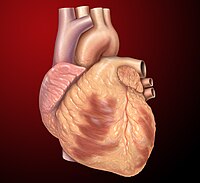
Photo from wikipedia
Aortic Stenosis (AS) is the most frequent valvulopathy in the western world. Traditionally aortic valve replacement (AVR) has been recommended immediately after the onset of heart failure (HF) symptoms. However,… Click to show full abstract
Aortic Stenosis (AS) is the most frequent valvulopathy in the western world. Traditionally aortic valve replacement (AVR) has been recommended immediately after the onset of heart failure (HF) symptoms. However, recent evidence suggests that AVR outcome can be improved if performed earlier. After AVR, the process of left ventricle (LV) reverse remodelling (RR) is variable and frequently incomplete. In this study, we aimed at detecting mechanism underlying the process of LV RR regarding myocardial structural, functional and molecular changes before the onset of HF symptoms. Wistar-Han rats were subjected to 7-weeks of ascending aortic-banding followed by a 2-week period of debanding to resemble AS-induced LV remodelling and the early events of AVR-induced RR, respectively. This resulted in 3 groups: Sham (n = 10), Banding (Ba, n = 15) and Debanding (Deb, n = 10). Concentric hypertrophy and diastolic dysfunction (DD) were patent in the Ba group. Aortic-debanding induced RR, which promoted LV functional recovery, while cardiac structure did not normalise. Cardiac parameters of RV dysfunction, assessed by echocardiography and at the cardiomyocyte level prevailed altered after debanding. After debanding, these alterations were accompanied by persistent changes in pathways associated to myocardial hypertrophy, fibrosis and LV inflammation. Aortic banding induced pulmonary arterial wall thickness to increase and correlates negatively with effort intolerance and positively with E/e′ and left atrial area. We described dysregulated pathways in LV and RV remodelling and RR after AVR. Importantly we showed important RV-side effects of aortic constriction, highlighting the impact that LV-reverse remodelling has on both ventricles.
Journal Title: Scientific Reports
Year Published: 2019
Link to full text (if available)
Share on Social Media: Sign Up to like & get
recommendations!